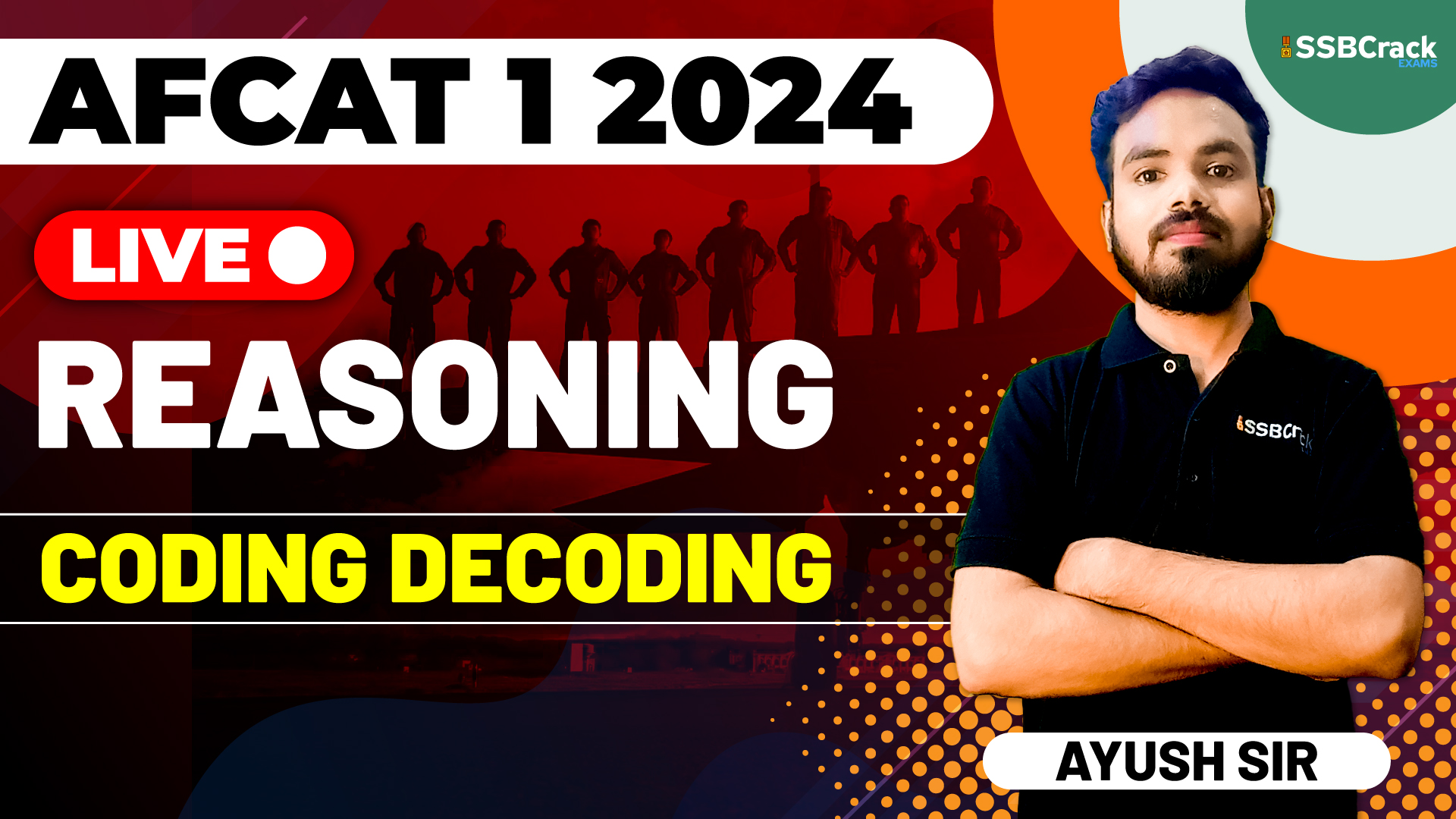As the AFCAT (Air Force Common Admission Test) and CDS (Combined Defence Services) exams for 2024 approach, candidates find themselves immersed in rigorous preparation. Among the multifaceted sections of these exams, Reasoning plays a pivotal role. One intriguing facet within the Reasoning section is Coding and Decoding—a skill that requires logical thinking and pattern recognition. In this live class dedicated to Coding and Decoding, important and previous year questions, along with fundamental concepts, were discussed and solved with innovative tricks. This article delves into the nuances of AFCAT-CDS 1 2024 Exam Reasoning – Coding and Decoding Class, highlighting key insights and strategies for effective problem-solving.
Understanding Coding and Decoding
Core Concepts of Coding and Decoding
1. Letter Coding
- Deciphering patterns in letter sequences to encode or decode information.
2. Number Coding
- Understanding numerical patterns used for coding and decoding.
3. Alphabet Coding
- Identifying relationships and patterns within the alphabet for coding purposes.
4. Symbol Coding
- Decoding or encoding messages using symbols and their specific patterns.
Solving Previous Year’s Important Questions
Question 1: Letter Coding
- If ‘APPLE’ is coded as ‘BQQMF’, how is ‘ORANGE’ coded?
- Trick: Identify the pattern of letter transformation. In this case, each letter is shifted one position forward in the alphabet.
- Solution: ‘ORANGE’ coded as ‘PSPOHF’.
- Explanation: The trick involves recognizing the consistent pattern applied to each letter in the coding process.
Question 2: Number Coding
- If ‘MARCH’ is coded as ‘135218’, how is ‘JUNE’ coded?
- Trick: Correlate letters to their respective numerical positions in the alphabet. Understand the numerical pattern for coding.
- Solution: ‘JUNE’ coded as ‘10145’.
- Explanation: The trick involves associating each letter with its alphabetical position to decode the numerical pattern.
Question 3: Alphabet Coding
- If ‘TIGER’ is coded as ‘UJHFS’, how is ‘LION’ coded?
- Trick: Understand the alphabetical relationship between the coded and decoded letters. In this case, each letter is shifted one position forward.
- Solution: ‘LION’ coded as ‘MJPO’.
- Explanation: Recognizing the consistent shift in the alphabet is essential for decoding.
Question 4: Symbol Coding
- If ‘@#$%’ is coded as ‘2531’, how is ‘$%’ coded?
- Trick: Establish a correlation between symbols and numerical values. Identify the pattern for encoding symbols.
- Solution: ‘$%’ coded as ’31’.
- Explanation: Understanding the symbolic representation of numerical values is crucial for decoding.
Tricks for Efficient Coding and Decoding Problem Solving
1. Recognizing Patterns
- Trick: Train your mind to recognize patterns in letter, number, or symbol coding. Look for consistent shifts or associations.
- Application: Recognizing patterns is the cornerstone of efficient coding and decoding problem-solving.
2. Associating Letters with Numbers
- Trick: Establish a mental association between letters and their numerical positions in the alphabet.
- Application: This trick is particularly useful in number coding, where letters are represented by their alphabetical positions.
3. Analyzing Symbolic Representations
- Trick: Understand the symbolic representations of numbers or letters. Identify the rules governing the encoding or decoding of symbols.
- Application: Symbol coding often involves assigning specific symbols to numerical or alphabetical values, and recognizing these associations is key.
4. Consistency in Shifting
- Trick: Note the consistency in shifting—whether it’s one position forward, backward, or following a different pattern.
- Application: Consistent shifting is a common feature in coding and decoding problems, and recognizing this consistency simplifies the process.
Analyzing Extra Complex Coding and Decoding Questions
Question 5: Mixed Coding
- If ’12$34′ is coded as ‘BXKD’, how is ’56$78′ coded?
- Trick: Observe the relationship between the numbers and letters. Decipher how numerical and symbolic elements contribute to the coding.
- Solution: ’56$78′ coded as ‘CDYEF’.
- Explanation: Mixed coding problems often involve decoding both numerical and symbolic elements.
Question 6: Alphanumeric Coding
- If ‘A3Z7B’ is coded as ‘C5Y9D’, how is ‘X9J2K’ coded?
- Trick: Recognize the coding pattern for both letters and numbers. Identify how alphanumeric elements are represented.
- Solution: ‘X9J2K’ coded as ‘ZBQ4L’.
- Explanation: Alphanumeric coding problems require a comprehensive understanding of both letters and numbers.
Strategies for Effective Coding and Decoding Problem-Solving
1. Break Down the Code
- Strategy: Dissect the given code into individual elements—letters, numbers, or symbols. Understand the code’s composition.
2. Identify the Pattern
- Strategy: Look for consistent patterns or rules governing the coding. Identify the relationships between the coded and decoded elements.
3. Tackle Different Elements Separately
- Strategy: If the coding involves letters, numbers, and symbols, tackle each element separately before combining them.
4. Use Trial and Error
- Strategy: If the pattern is not immediately evident, use trial and error by testing different hypotheses until a consistent pattern emerges.
5. Verify the Solution
- Strategy: After decoding, verify the solution by cross-referencing it with the original code. Ensure that the decoded elements align with the given information.
Conclusion
In conclusion, AFCAT-CDS 1 2024 Exam Reasoning – Coding and Decoding Class delved into the intricacies of coding and decoding problems, providing candidates with essential skills and tricks. The ability to decipher patterns in letters, numbers, and symbols is a critical aspect of reasoning, and mastering this skill is vital for success in competitive exams. By understanding the core concepts, applying efficient tricks, and employing strategic problem-solving approaches, candidates can confidently approach coding and decoding questions. Regular practice, exposure to diverse problems, and a systematic approach will undoubtedly contribute to success in tackling the complexities of coding and decoding. Best of luck in your preparation for the AFCAT-CDS 1 2024 Exam and your journey towards a fulfilling career in defense services!



















